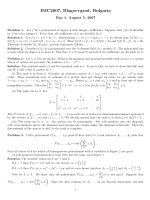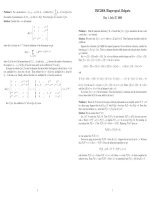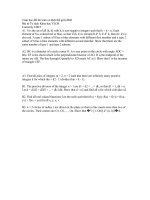Tài liệu Đề thi Olympic sinh viên thế giới năm 1997 ngày 2 docx
Bạn đang xem bản rút gọn của tài liệu. Xem và tải ngay bản đầy đủ của tài liệu tại đây (90.05 KB, 5 trang )
FOURTH INTERNATIONAL COMPETITION
FOR UNIVERSITY STUDENTS IN MATHEMATICS
July 30 – August 4, 1997, Plovdiv, BULGARIA
Second day — August 2, 1997
Problems and Solutions
Problem 1.
Let f be a C
3
(R) non-negative function, f(0)=f
(0)=0, 0 < f
(0).
Let
g(x) =
f(x)
f
(x)
for x = 0 and g(0) = 0. Show that g is bounded in some neighbourhood of 0.
Does the theorem hold for f ∈ C
2
(R)?
Solution.
Let c =
1
2
f
(0). We have
g =
(f
)
2
− 2ff
2(f
)
2
√
f
,
where
f(x) = cx
2
+ O(x
3
), f
(x) = 2cx + O(x
2
), f
(x) = 2c + O(x).
Therefore (f
(x))
2
= 4c
2
x
2
+ O(x
3
),
2f(x)f
(x) = 4c
2
x
2
+ O(x
3
)
and
2(f
(x))
2
f(x) = 2(4c
2
x
2
+ O(x
3
))|x|
c + O(x).
g is bounded because
2(f
(x))
2
f(x)
|x|
3
−→
x→0
8c
5/2
= 0
and f
(x)
2
− 2f(x)f
(x) = O(x
3
).
The theorem does not hold for some C
2
-functions.
1
Let f (x) = (x + |x|
3/2
)
2
= x
2
+ 2x
2
|x| + |x|
3
, so f is C
2
. For x > 0,
g(x) =
1
2
1
1 +
3
2
√
x
= −
1
2
·
1
(1 +
3
2
√
x)
2
·
3
4
·
1
√
x
−→
x→0
−∞.
Problem 2.
Let M be an invertible matrix of dimension 2n × 2n, represented in
block form as
M =
A B
C D
and M
−1
=
E F
G H
.
Show that det M. det H = det A.
Solution.
Let I denote the identity n × n matrix. Then
det M. det H = det
A B
C D
· det
I F
0 H
= det
A 0
C I
= det A.
Problem 3.
Show that
∞
n=1
(−1)
n−1
sin (log n)
n
α
converges if and only if α > 0.
Solution.
Set f (t) =
sin (log t)
t
α
. We have
f
(t) =
−α
t
α+1
sin (log t) +
cos (log t)
t
α+1
.
So |f
(t)| ≤
1 + α
t
α+1
for α > 0. Then from Mean value theorem for some
θ ∈ (0, 1) we get |f(n+1)−f(n)| = |f
(n+θ)| ≤
1 + α
n
α+1
. Since
1 + α
n
α+1
< +∞
for α > 0 and f(n) −→
n→∞
0 we get that
∞
n=1
(−1)
n−1
f(n) =
∞
n=1
(f(2n−1)−f(2n))
converges.
Now we have to prove that
sin (log n)
n
α
does not converge to 0 for α ≤ 0.
It suffices to consider α = 0.
We show that a
n
= sin (log n) does not tend to zero. Assume the
contrary. There exist k
n
∈ N and λ
n
∈
−
1
2
,
1
2
for n > e
2
such that
log n
π
=
k
n
+ λ
n
. Then |a
n
| = sin π|λ
n
|. Since a
n
→ 0 we get λ
n
→ 0.
2
We have k
n+1
− k
n
=
=
log(n + 1) − log n
π
− (λ
n+1
− λ
n
) =
1
π
log
1 +
1
n
− (λ
n+1
− λ
n
).
Then |k
n+1
− k
n
| < 1 for all n big enough. Hence there exists n
0
so that
k
n
= k
n
0
for n > n
0
. So
log n
π
= k
n
0
+ λ
n
for n > n
0
. Since λ
n
→ 0 we get
contradiction with log n → ∞.
Problem 4.
a) Let the mapping f : M
n
→ R from the space
M
n
= R
n
2
of n × n matrices with real entries to reals be linear, i.e.:
(1) f(A + B) = f(A) + f(B), f (cA) = cf(A)
for any A, B ∈ M
n
, c ∈ R. Prove that there exists a unique matrix C ∈ M
n
such that f(A) = tr(AC) for any A ∈ M
n
. (If A = {a
ij
}
n
i,j=1
then
tr(A) =
n
i=1
a
ii
).
b) Suppose in addition to (1) that
(2) f(A.B) = f(B.A)
for any A, B ∈ M
n
. Prove that there exists λ ∈ R such that f(A) = λ.tr(A).
Solution.
a) If we denote by E
ij
the standard basis of M
n
consisting of elementary
matrix (with entry 1 at the place (i, j) and zero elsewhere), then the entries
c
ij
of C can be defined by c
ij
= f(E
ji
). b) Denote by L the n
2
−1-dimensional
linear subspace of M
n
consisting of all matrices with zero trace. The elements
E
ij
with i = j and the elements E
ii
−E
nn
, i = 1, . . . , n −1 form a linear basis
for L. Since
E
ij
= E
ij
.E
jj
− E
jj
.E
ij
, i = j
E
ii
− E
nn
= E
in
.E
ni
− E
ni
.E
in
, i = 1, . . . , n −1,
then the property (2) shows that f is vanishing identically on L. Now, for
any A ∈ M
n
we have A −
1
n
tr(A).E ∈ L, where E is the identity matrix, and
therefore f (A) =
1
n
f(E).tr(A).
3
Problem 5.
Let X be an arbitrary set, let f be an one-to-one function mapping
X onto itself. Prove that there exist mappings g
1
, g
2
: X → X such that
f = g
1
◦ g
2
and g
1
◦ g
1
= id = g
2
◦ g
2
, where id denotes the identity mapping
on X.
Solution.
Let f
n
= f ◦ f ◦ ··· ◦ f
n times
, f
0
= id, f
−n
= (f
−1
)
n
for every natural
number n. Let T (x) = {f
n
(x) : n ∈ Z} for every x ∈ X. The sets T (x) for
different x’s either coinside or do not intersect. Each of them is mapped by f
onto itself. It is enough to prove the theorem for every such set. Let A = T (x).
If A is finite, then we can think that A is the set of all vertices of a regular
n polygon and that f is rotation by
2π
n
. Such rotation can be obtained as a
composition of 2 symmetries mapping the n polygon onto itself (if n is even
then there are axes of symmetry making
π
n
angle; if n = 2k + 1 then there
are axes making k
2π
n
angle). If A is infinite then we can think that A = Z
and f (m) = m + 1 for every m ∈ Z. In this case we define g
1
as a symmetry
relative to
1
2
, g
2
as a symmetry relative to 0.
Problem 6.
Let f : [0, 1] → R be a continuous function. Say that f “crosses the
axis” at x if f(x) = 0 but in any neighbourhood of x there are y, z with
f(y) < 0 and f(z) > 0.
a) Give an example of a continuous function that “crosses the axis”
infiniteley often.
b) Can a continuous function “cross the axis” uncountably often?
Justify your answer.
Solution.
a) f (x) = x sin
1
x
.
b) Yes. The Cantor set is given by
C = {x ∈ [0, 1) : x =
∞
j=1
b
j
3
−j
, b
j
∈ {0, 2}}.
There is an one-to-one mapping f : [0, 1) → C. Indeed, for x =
∞
j=1
a
j
2
−j
,
a
j
∈ {0, 1} we set f(x) =
∞
j=1
(2a
j
)3
−j
. Hence C is uncountable.
4
For k = 1, 2, . . . and i = 0, 1, 2, . . . , 2
k−1
− 1 we set
a
k,i
= 3
−k
6
k−2
j=0
a
j
3
j
+ 1
, b
k,i
= 3
−k
6
k−2
j=0
a
j
3
j
+ 2
,
where i =
k−2
j=0
a
j
2
j
, a
j
∈ {0, 1}. Then
[0, 1) \ C =
∞
k=1
2
k−1
−1
i=0
(a
k,i
, b
k,i
),
i.e. the Cantor set consists of all points which have a trinary representation
with 0 and 2 as digits and the points of its compliment have some 1’s in their
trinary representation. Thus,
2
k−1
−1
∪
i=0
(a
k,i
, b
k,i
) are all points (exept a
k,i
) which
have 1 on k-th place and 0 or 2 on the j-th (j < k) places.
Noticing that the points with at least one digit equals to 1 are every-
where dence in [0,1] we set
f(x) =
∞
k=1
(−1)
k
g
k
(x).
where g
k
is a piece-wise linear continuous functions with values at the knots
g
k
a
k,i
+ b
k,i
2
= 2
−k
, g
k
(0) = g
k
(1) = g
k
(a
k,i
) = g
k
(b
k,i
) = 0,
i = 0, 1, . . . , 2
k−1
− 1.
Then f is continuous and f “crosses the axis” at every point of the
Cantor set.
5









